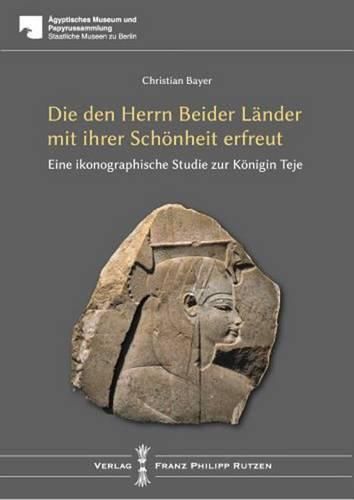Readings Newsletter
Become a Readings Member to make your shopping experience even easier.
Sign in or sign up for free!
You’re not far away from qualifying for FREE standard shipping within Australia
You’ve qualified for FREE standard shipping within Australia
The cart is loading…






English summary: No Queen of the New Kingdom of Egypt, other than Nefertiti, has as prominent a role in Egyptian art as Tiye, the Great Royal Wife of Amenhotep III. The range of her appearances covers virtually the entire spectrum of Egyptian visual media from groups of monumental statues to small wooden figurines, from temple reliefs and sepulchral paintings to scarabs and cylinder seals, and from stelae to decorative jewelry and articles of everyday use. With this study, Christian Bayer is the first to present the complete portraits of Queen Tiye and to discuss their iconography and exact dating in detail. So far, researchers have divided the development of the royal art style of Amenhotep III into four consecutive phases, whereby the so-called baroque phase shortly before the pharaoh’s death is generally seen as being the pinnacle. Bayer questions this categorization and shows that this development might not have taken place in consecutive phases after all: the baroque period should more likely represent the third phase, after which Amenhotep III returned to a more classical style as shown in buildings constructed for the Sed festival towards the end of his reign. German description: Keine andere Konigin des Neuen Reiches ausser Nofretete tritt im Denkmalerbestand derart prominent in Erscheinung wie Teje, die Grosse Konigsgemahlin Amenhoteps III. Die Spannbreite ihres Auftretens umfasst nahezu das gesamte Spektrum agyptischer Bildmedien von monumentalen Statuengruppen bis zu kleinen Holzfigurchen, von Tempelreliefs und Grabmalereien bis zu Skarabaen und Rollsiegeln, von Stelen bis zu dekorativen Schmuck- und Gebrauchsgegenstanden. Christian Bayer stellt in seiner Studie erstmals alle Bildnisse der Konigin Teje ausfuhrlich vor und diskutiert eingehend ihre Ikonographie und mogliche Feindatierung. Bislang wurde die Entwicklung des koniglichen Kunststils Amenhoteps III. von der Forschung in vier linear aufeinanderfolgende Phasen eingeteilt, wobei die sogenannte barocke Phase als Gipfelpunkt kurz vor dem Tod des Herrschers interpretiert wurde. Bayer stellt diese Einteilung in Frage und kann zeigen, dass die Entwicklung im Gegenteil nicht-linear verlaufen sein durfte: Die barocke Phase wurde demnach die dritte Phase darstellen, in deren Anschluss Amenhotep III. mit den Sedfest-Bauten am Ende seiner Regierung zu einer klassischeren Darstellungsweise zuruckgekehrt ist.
$9.00 standard shipping within Australia
FREE standard shipping within Australia for orders over $100.00
Express & International shipping calculated at checkout
Stock availability can be subject to change without notice. We recommend calling the shop or contacting our online team to check availability of low stock items. Please see our Shopping Online page for more details.
English summary: No Queen of the New Kingdom of Egypt, other than Nefertiti, has as prominent a role in Egyptian art as Tiye, the Great Royal Wife of Amenhotep III. The range of her appearances covers virtually the entire spectrum of Egyptian visual media from groups of monumental statues to small wooden figurines, from temple reliefs and sepulchral paintings to scarabs and cylinder seals, and from stelae to decorative jewelry and articles of everyday use. With this study, Christian Bayer is the first to present the complete portraits of Queen Tiye and to discuss their iconography and exact dating in detail. So far, researchers have divided the development of the royal art style of Amenhotep III into four consecutive phases, whereby the so-called baroque phase shortly before the pharaoh’s death is generally seen as being the pinnacle. Bayer questions this categorization and shows that this development might not have taken place in consecutive phases after all: the baroque period should more likely represent the third phase, after which Amenhotep III returned to a more classical style as shown in buildings constructed for the Sed festival towards the end of his reign. German description: Keine andere Konigin des Neuen Reiches ausser Nofretete tritt im Denkmalerbestand derart prominent in Erscheinung wie Teje, die Grosse Konigsgemahlin Amenhoteps III. Die Spannbreite ihres Auftretens umfasst nahezu das gesamte Spektrum agyptischer Bildmedien von monumentalen Statuengruppen bis zu kleinen Holzfigurchen, von Tempelreliefs und Grabmalereien bis zu Skarabaen und Rollsiegeln, von Stelen bis zu dekorativen Schmuck- und Gebrauchsgegenstanden. Christian Bayer stellt in seiner Studie erstmals alle Bildnisse der Konigin Teje ausfuhrlich vor und diskutiert eingehend ihre Ikonographie und mogliche Feindatierung. Bislang wurde die Entwicklung des koniglichen Kunststils Amenhoteps III. von der Forschung in vier linear aufeinanderfolgende Phasen eingeteilt, wobei die sogenannte barocke Phase als Gipfelpunkt kurz vor dem Tod des Herrschers interpretiert wurde. Bayer stellt diese Einteilung in Frage und kann zeigen, dass die Entwicklung im Gegenteil nicht-linear verlaufen sein durfte: Die barocke Phase wurde demnach die dritte Phase darstellen, in deren Anschluss Amenhotep III. mit den Sedfest-Bauten am Ende seiner Regierung zu einer klassischeren Darstellungsweise zuruckgekehrt ist.